Social Media Addiction Statistics Revealed: What Your Daily Scrolling Really Means
Share your love
The numbers paint a troubling picture of social media addiction. A staggering 56.8% of the world's population actively uses social media, and our casual scrolling has transformed into a potential dependency for millions. Research shows that about 210 million people worldwide struggle with addiction to social media and the internet.
The situation in America looks even more concerning. Nearly 10% of Americans – approximately 33.19 million people – show signs of social media addiction compared to regular users. Social media's grip on society has tightened significantly over time.
The percentage of American social media users jumped from just 5% in 2005 to an overwhelming 69.7% by 2024. People worldwide spend an average of two hours and 27 minutes daily on social media platforms.
Americans clock in slightly lower at two hours and 15 minutes each day. Many users don't realize their harmless-looking scrolling habits could signal a more serious issue. This piece dives deep into social media addiction's scope, identifies the most vulnerable groups, and explains how these statistics affect our everyday lives.
How many people are addicted to social media?
Social media addiction affects more people than you might think. Research shows about 210 million people worldwide are addicted to social media and the internet. This accounts for 4-5% of all social media users across the globe. These numbers can change by a lot based on how experts define and measure addiction.
Global estimates of social media addiction
A detailed meta-analysis with 63 independent samples from 32 nations, which included 34,798 respondents, showed notable differences in how common this addiction is. Studies that used strict criteria found about 5% of people were addicted. This number jumped to 13% in studies that looked at severe addiction, and reached 25% when measuring moderate addiction levels.
Culture plays a big role in these addiction rates. People in collectivist nations (31%) show addiction rates twice as high as those in individualist nations (14%). This tells us that social pressures and cultural norms shape how people use social media platforms.
Teen addiction rates range from 5% to 20%, depending on the study criteria. About 36% of teenagers say they spend too much time on social media, and 40.6% admit it hurts their sleep.
U.S. statistics and trends over time
American social media addiction follows some global patterns but has its unique features. About 10% of Americans—roughly 33.19 million people—can't stop using social media.
Addiction rates vary widely across age groups:
- 18 to 22 years: 40% self-report being addicted
- 23 to 38 years: 37% self-report being addicted
- 38 to 54 years: 26% self-report being addicted
- 55 to 64 years: 21% self-report being addicted
These numbers paint a worrying picture. Only 5% of Americans used social media platforms in 2005. This number exploded to 69.7% by 2024. Daily usage time dropped slightly from 151 minutes to 143 minutes, but the overall trend keeps climbing.
Gender differences stand out too. About 34% of women report addiction compared to 26% of men. Research suggests men might actually develop addiction more easily despite reporting lower rates.
Why these numbers are rising
Several factors propel social media addiction's growth. Social networking sites create an environment that triggers dopamine release. Research shows likes, shares, and comments spark chemical reactions in our brain's reward system, just like cocaine does.
Your smartphone works like a modern-day "hypodermic needle" that delivers digital dopamine instantly. Users' brains enter a dopamine-deficit state after logging off, which creates a cycle that feels great during use but terrible right after stopping.
People now use more than six different platforms. This number jumped from 4.3 accounts per person in 2013 to almost 9 today. Using multiple platforms increases exposure and potential dependency.
College students face a particularly tough challenge, with over 60% saying they're addicted to social media. Young users aged 16-24 spend lots of time online – females average 2 hours and 59 minutes daily, while males spend about 2 hours and 38 minutes.
These numbers will likely keep rising as social media merges more into our daily lives, unless we find effective ways to intervene.
Addiction by age, gender, and race
Social media addiction hits young people hardest among all groups. Different age groups, genders, and racial backgrounds show unique patterns in how social media platforms affect them. Some groups face much higher risks of developing problematic usage habits.
Teens and young adults: the most affected group
Young generations lead the pack in social media addiction rates. A whopping 40% of Americans aged 18-22 say they're addicted to social media. These numbers drop with age – 37% for 23-38 year-olds, 26% for 38-54 year-olds, and 21% for 55-64 year-olds admit to addiction.
Teenagers face similar challenges. About 93-97% of teens aged 13-17 use at least one social media platform and spend roughly 3 hours daily on these sites. A newer study, published in 2023 by Pew Research shows 46% of teens describe their internet use as "almost constant". About 24.4% of adolescents qualify as social media addicts based on clinical criteria.
Young users' vulnerability comes from multiple sources. Their developing brains react more strongly to addiction and negative effects. Social pressure during identity formation makes them chase validation through social media. Many teens say online interactions disrupt their daily lives.
Gender differences in addiction patterns
Looking at social media addiction between genders reveals interesting trends. Women seem more affected at first glance – 34% say they're somewhat addicted to social media (with 11% without doubt addicted), compared to 26% of men (only 7% admit definite addiction).
Recent studies paint a different picture. Men might actually be more prone to social media addiction than women. 66.4% of social media addicts identify as male. This gap between self-reported addiction and actual behavior shows how differently men and women use these platforms.
Men and women get hooked on social media for different reasons. Women use social media mainly to connect with others. They spend 2.08 hours daily on these platforms while men spend 1.81 hours. Men prefer online gaming, cybersex, and competitive activities that trigger reward-related brain regions differently.
Platform choices split clearly between genders. Snapchat (60%), Pinterest (78%), Instagram (57%), and TikTok (59%) attract more women. Twitter (68%), YouTube (55%), and Facebook (56%) draw more men.
Ethnic and racial disparities in usage and addiction
Race and ethnicity play a big role in social media addiction. Statista data shows 32% of White users report social media addiction, compared to 29% of Hispanic users, 27% of Asian users, and 25% of African American users.
Usage patterns tell a different story. Black and Hispanic teens spend more time on social media than white teens. 55% of Hispanic teens and 54% of Black teens say they're online "almost constantly." Only 38% of white teens report the same. TikTok usage varies too – one-third of Hispanic teens use it "almost constantly," compared to one-fifth of Black teens and just one-tenth of white teens.
Different ethnic groups prefer different platforms. YouTube reaches across all racial groups – 84% of Black Americans, 85% of Hispanic Americans, and 79% of White Americans use it. Instagram shows bigger differences: 52% of Hispanic Americans, 49% of Black Americans, and only 35% of White Americans use this platform.
These differences matter beyond just numbers. Research with Black, Asian, Indigenous, and Latinx teens shows that racial discrimination on social media relates to more depression, anxiety, and substance use disorders. This shows how minority groups might face extra mental health challenges from their social media use.
Which platforms are the most addictive?
Social media platforms compete for our attention, but TikTok stands out as the most addictive social media platform in 2025. YouTube and Instagram follow right behind. These platforms excel at holding user attention through smart algorithms and content that hooks viewers.
TikTok, Instagram, and YouTube usage stats
TikTok leads the pack in addictiveness with 2,482.50 monthly searches from users trying to cut back their screen time. These numbers show users know they spend too much time on the app. The platform dominates globally as users spend 34 hours per month on its Android app.
YouTube takes second place with 987.50 monthly searches from people trying to manage their screen time. Users spend 28 hours and 5 minutes per month watching videos on this platform. The platform reaches 95% of teens aged 13-17, making it the most popular choice among young people.
Instagram comes in third with 1,422.50 monthly searches from users wanting to reduce their screen time. People spend about 16 hours per month on the platform. The platform ranks as the world's "favorite" social media platform despite lower usage times.
Daily usage time by platform
Daily platform usage reveals some worrying trends. TikTok users spend average of 52-58.4 minutes per day on the app. This shows a huge 31-minute increase since 2019. Users now spend more than an hour every day scrolling through endless TikTok content.
YouTube viewers watch content for 45-48.7 minutes daily. Their sessions last 7 minutes and 25 seconds – much longer than other platforms. Instagram users browse feeds, Stories, and Reels for 29-33.9 minutes daily. Their sessions last just 2 minutes and 44 seconds.
Facebook might appeal less to younger users now, but people still spend 31-33 minutes daily on the platform. This shows a 20% decrease since 2017, which points to changing social media priorities.
Why some platforms are more addictive than others
These platforms hook users through features designed to maximize engagement. TikTok's algorithm keeps users glued to content that matches their interests. Short videos grab attention fast, making it hard to stop scrolling.
Smartphones serve as modern-day hypodermic needles that deliver digital dopamine through bright colors, flashing lights, and engaging alerts. This matches TikTok's endless content stream perfectly.
Our brains release dopamine when making connections – a survival trait humans have relied on for millions of years. Social media apps have turned this natural response into something like a drug, triggering massive dopamine releases similar to recreational drugs.
These platforms tap into our desire for new experiences. Human brains notice new things naturally, and algorithms learn from our past likes to suggest content that feels fresh but familiar. Video platforms create perfect conditions for addiction by putting this content front and center.
Users feel the effects when they log off. The brain struggles to adjust as it enters a dopamine-deficit state after experiencing unnaturally high levels. This explains why social media feels great during use but terrible right after – creating a cycle that pulls users back repeatedly.
Mental and physical effects of social media addiction
Social media addiction wreaks havoc on mental and physical health. Statistics show troubling rates of psychological distress among heavy users. Research proves that social media addiction leads to more anxiety, depression, and serious sleep disorders that change how the brain works.
Anxiety, depression, and body image issues
Research clearly shows the link between social media use and mental health problems. Studies reveal that 48.3% of frequent social media users deal with depression, 22.6% face anxiety, and 19.4% struggle with both conditions at once.
The problem gets worse as usage increases. A complete meta-analysis found that each extra hour teens spend on social media platforms raises their depression risk by 13%.
Anxiety about looks is another serious effect of too much social media use. These platforms create endless opportunities to compare yourself to others, making users more worried about their appearance. People who spend more time on social media tend to be more fixated on how they look. Users often end up with poor body image when they compare themselves to edited, filtered versions of others online.
Young adults face the worst effects. Research about Lebanese young adults shows that problematic social media use links to higher rates of depression, anxiety, and insomnia. Stress plays a key role in causing these conditions.
Sleep disruption and attention problems
Too much social media seriously hurts sleep quality. Studies show teens who overuse social media sleep poorly, with clear evidence linking heavy use to disrupted sleep. About 21% of adults wake up at night just to check their phones. Even more surprising, 70% of people use social media after getting into bed.
These disruptions change our biology. Screen's blue light blocks melatonin production, which delays sleep and makes it less restful. This affects REM sleep and makes it harder for our brains to process emotions and store memories. Late-night scrolling doesn't just keep you up – it changes how well you sleep.
Social media addiction causes attention problems through constant interruptions and multitasking. People who often switch between digital tasks get distracted more easily and perform worse at switching between tasks than those who rarely multitask. Our brains learn to crave constant stimulation, which makes it harder to focus on one thing.
The dopamine loop and brain rewiring
A powerful brain chemical process drives these effects. Social media triggers big dopamine releases in the brain's reward system, just like heroin or alcohol. Logging off drops the brain into a dopamine deficit while it tries to adjust to unnaturally high neurotransmitter levels. This creates a cycle where social media feels great during use but terrible right after.
This process reshapes the brain over time. Too much social media can shrink gray matter in the amygdala – the brain's emotion and impulse center. Platform addiction also disrupts the frontostriatal pathway, making people more sensitive to stimuli while reducing their self-control.
Changes in the basal ganglia, amygdala, and prefrontal cortex raise serious concerns.
Problems in these three areas make people focus more on quick rewards while weakening their decision-making and emotional control. These effects can permanently impact cognitive function and emotional health in teens whose brains are still growing.
Behavioral signs and risk factors
Social media addiction shows itself through specific behavior patterns that set it apart from regular usage. Research shows six key behaviors that signal when your scrolling has turned into something more serious.
What compulsive use looks like
Social media addiction goes beyond spending too much time online—it changes how you live and feel. Users first notice mood changes that guide them toward positive emotional shifts. Soon, social media takes over their thoughts, emotions, and actions.
People need more and more platform time to feel satisfied as their tolerance grows. They feel anxious, depressed, irritable, and moody when cut off from social media. Some cases even lead to insomnia and psychosis. This ended up creating problems with their relationships and daily responsibilities.
The biggest red flag appears when users try to cut back but can't stay away for long.
Medical experts suggest you ask yourself these six questions to spot addiction risks:
- Do you spend a lot of time thinking about or planning your social media use?
- Do you feel stronger urges to use social media?
- Do you use social media to avoid your problems?
- Have you failed to cut back on social media use?
- Do you get anxious when you can't access your accounts?
- Has social media hurt your work or studies?
You might have an addiction if you answer "yes" to three or more questions.
Selfitis and ringxiety explained
Selfitis started as a fake story but grew into a real psychological issue. It shows up as an obsessive need to take and post selfies. Research breaks selfitis into three levels: borderline (three daily selfies, no posting), acute (three or more posted selfies daily), and chronic (non-stop selfie-taking with six-plus daily posts).
A study of 440 college students showed more than half had borderline selfitis and a third showed chronic selfitis. Selfitis links directly to how people see their bodies. Research shows that people who take more selfies tend to feel worse about their appearance.
Ringxiety makes people think their phone buzzed when it didn't. This happens because they worry about missing notifications.
Associated habits: junk food, smoking, and more
Social media addiction often brings other problems along with it. Users who can't control their usage make poor food choices. Research links too much platform time with eating more junk food.
Beauty standards on social platforms make eating disorders worse, especially bulimia. Studies show that teens develop more eating disorders and worry more about their looks because of social media's beauty standards.
Social media addicts sleep poorly, as confirmed by multiple studies. Many more harmful behaviors pop up, like smoking more and using other substances. These issues hit harder if you face discrimination on these platforms.
Can social media addiction be treated?
Social media addiction responds well to treatment through therapy, education, and support programs. Professional help can empower people to take back control of their social media habits.
Therapies used in treatment
CBT remains the most effective way to treat social media addiction. This therapy helps people spot unhealthy thought patterns and build better coping skills. DBT works in a similar way by teaching mindfulness techniques that help patients handle intense emotions leading to compulsive social media use.
Patients who go through motivational interviewing often deepen their commitment to cutting back on social media. Licensed therapists lead group sessions that offer great benefits – from peer support and accountability to learning different recovery strategies from others.
Challenges in recovery
Modern life makes it hard to completely stay away from social media, unlike other addictions. Your brain creates new pathways during recovery, but the old addictive patterns stick around, which makes relapse more likely. On top of that, recovery becomes harder when you experience withdrawal symptoms like anxiety, depression, mood swings, and sleep problems.
Prevention strategies for parents and users
The good news is that smart prevention strategies can substantially lower addiction risks. Parents find success by setting clear screen time boundaries and creating tech-free zones at home. Special apps help track usage patterns and make you more aware of your social media habits.
Finding offline activities and hobbies gives you better alternatives than endless scrolling.
Open conversations about social media use raise awareness about what it all means without making users feel judged.
Conclusion
Social media addiction has become a global crisis that affects hundreds of millions of people worldwide. The numbers paint a grim picture – what started as casual entertainment has turned into psychological dependency for about 210 million people globally. This addiction now grips roughly 10% of Americans, and younger generations are especially vulnerable to its pull.
The addiction rates show clear patterns across different groups. Young people face the highest risk, as nearly half of teens report they use the internet "almost constant." Gender plays a vital role too, but its effects show up in complex ways that go beyond basic usage numbers. Social media disrupts various communities differently and can make existing social challenges worse.
TikTok stands out as the most addictive social media app, with YouTube and Instagram right behind it. These apps use our brain chemistry against us and create powerful dopamine loops that keep us coming back despite the downsides. Our smartphones have essentially become modern hypodermic needles that deliver digital dopamine straight to our reward systems.
The effects of this addiction go way beyond lost time. Heavy social media use links directly to anxiety, depression, poor sleep, and focus problems. These platforms actually rewire our brains and change how we control impulses and make decisions. Young brains in development might carry these changes for life.
More people now accept social media addiction as a real condition. Recovery brings unique challenges since staying completely off social media isn't practical today, but treatments work. CBT, DBT, and group support programs have helped many people break free from their addiction.
Awareness remains our best defense against social media addiction. Learning the warning signs, setting healthy limits, and talking openly about digital use helps reduce risks. Social media has its benefits, but the numbers make it clear – we need to watch our scrolling habits carefully before they turn into something more harmful than entertainment.
FAQs
Q1. What percentage of people are addicted to social media?
Research indicates that approximately 4-5% of all social media users globally suffer from addiction. However, this number can vary significantly depending on how addiction is defined and measured. In the United States, about 10% of the population is considered addicted to social media.
Q2. How much time do people typically spend on social media daily?
On average, people globally spend about 2 hours and 27 minutes on social media every day. Americans specifically spend slightly less, averaging 2 hours and 15 minutes daily on social media platforms.
Q3. Which age group is most affected by social media addiction?
Teens and young adults are the most affected group. Among Americans aged 18-22, 40% self-report being addicted to social media. This percentage gradually decreases with age, with only 21% of those aged 55-64 acknowledging addiction.
Q4. What are the mental health effects of excessive social media use?
Excessive social media use is linked to increased rates of anxiety and depression. Studies show that 48.3% of frequent social media users experience depression, 22.6% suffer from anxiety, and 19.4% struggle with both conditions simultaneously. It can also lead to sleep disruption and attention problems.
Q5. Which social media platform is considered the most addictive?
TikTok is currently considered the most addictive social media platform. Users spend an average of 52-58.4 minutes per day on the app, which is significantly higher than other platforms. Its algorithm is particularly effective at keeping users engaged with content that resonates with their interests.




